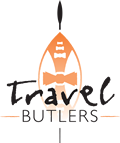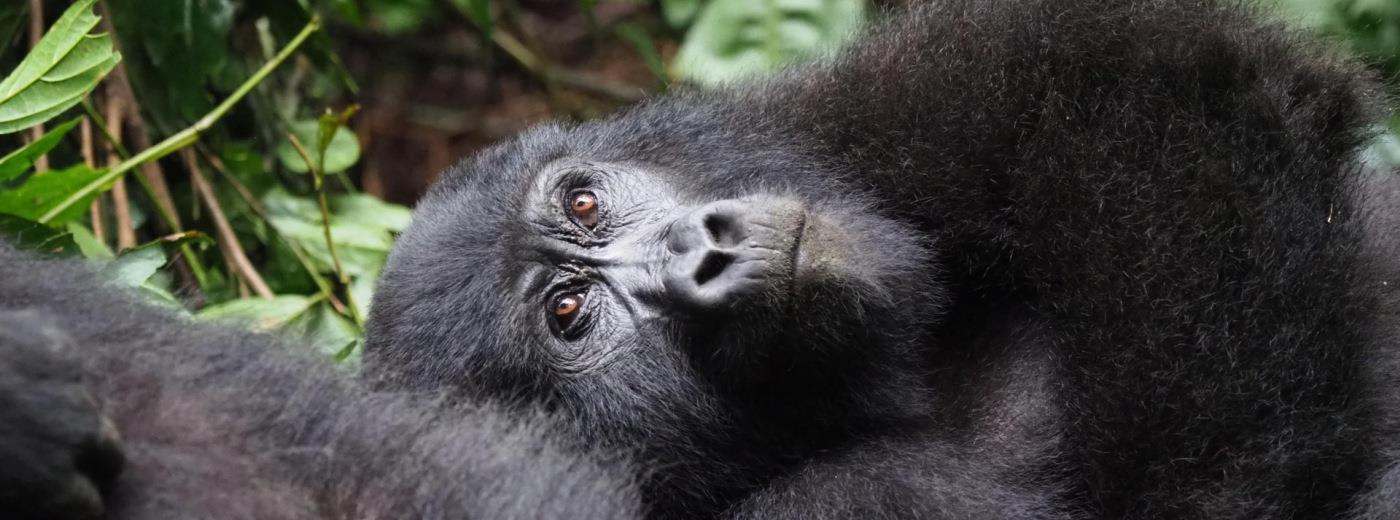Age Limits, What to Take And More
Tracking Gorillas and Chimpanzees
Gorilla trekking timings and conditions vary tremendously as the gorillas move continuously through the rain forest. It is good to be prepared and remember the weather can change with very little warning. The terrain is often steep and through areas where there are no marked paths.
It can be VERY strenuous - it may be just a couple of hours but it can also be for a full day of up to 8 hours or more of hiking in hot, high altitude conditions - please be prepared for this by being as fit as possible!
Chimpanzee trekking is generally not as difficult compared to gorilla trekking but still can be a hard hike and requires a good level of fitness - especially if you need to follow the chimps which can move swiftly through the forest.
You will be guided through the forest on your gorilla/chimp adventure by a guide whom you will meet at the departure point in the morning of your trek. Your guide can help you book a porter if required (an additional cost of approximately USD 20 per porter per day - subject to change) so that you can trek without having to carry the few essential items listed below in a day pack which you should bring with you. The porters are from the local community and very used to the local conditions and can assist in pushing, pulling and supporting you during your walk to the gorillas.
As the porters do not have trekking permits they will stop a short distance from the point you will be viewing the mountain gorillas. Please remember to take whatever you may need from your bag to view the gorillas and leave valuables at the lodge/camp for security reasons.
You will be allowed up to one hour for viewing of the gorillas/chimps from when they are sighted by your group. This is to ensure that the wild animals are not over exposed to human presence. Whilst in their presence you will also be required to keep minimum distances from them - generally around 10 metres and your guides will ensure this is enforced. However, should the group become agitated, for your own safety your guide may suggest moving away before the hour is completed.
Keep your voices down when you are with the animals - but it is OK to ask the guide questions in a low voice. Do not smoke, eat or drink while near the animals either. And of course, it goes without saying please do not touch the animals at all!
Packing list for day pack for trekking:
- Plenty of water - 1-2 litres per person
- High energy snacks in addition to your packed lunch provided by the lodge/camp
- Passport - as these details are required when at the initial briefing/registration point
- Spare memory and batteries for videos and camera
- Binoculars
- Gloves (gardening type are good)
- Face mask - now required when viewing the gorilla family
- Waterproof bag to protect photographic equipment
- A hat, sunscreen, mosquito repellent and band aids might be useful
- A lightweight waterproof jacket
- Walking sticks are made available at the start of the trek for some of the steeper and more slippery tracks and may prove to be useful
Gorilla and Chimp Trekking Age Limits
The age limit for gorilla trekking is 15 and for chimp trekking it is 12 years and the authorities are very strict on this, kindly make sure all children are therefore old enough to join in the activities order to avoid any sad incidents like children being refused to go on the trek!
Gorilla and Chimpanzee Trekking Health Requirements
Mountain gorillas and chimpanzees are highly susceptible to human diseases including flu and colds. If you are participating in a gorilla/chimp trek then you need to be free of any visibly contagious diseases and this is checked at the start of the trek by the Park Authorities. If they are in any doubt of your condition, they reserve the right to prevent you from continuing on the trek. Our advice is that if you feel you are worried about this aspect, you please inform your safari guide as soon as possible, and he will seek advice as to the best way to manage the situation. You are also required now to wear a face mask when with your gorilla family at all times.
Clothing on Your Gorilla/Chimpanzee Safari
On a trip through the rainforests you can experience all 4 seasons. It will also be necessary to take some wet weather gear as it does rain in the mountainous areas on a regular basis. We suggest lightweight rain gear for the hike to view the gorillas.
During your stay at your lodge, depending on the style of trip chosen, dress code may vary slightly. None of the lodges/hotels insist on any formal type of dress - ties, jackets etc - so the norm would be casual or smart casual depending upon the level. In towns and cities, and at certain of the more up-market lodges and hotels then long trousers and shirt/golf shirt would be more appropriate (especially in the evenings), or ladies may wear a skirt of course! Bush gear ie hard wearing clothes, no bright colours, eg greens, khaki and similar neutral clothes arerecommended. In the day time around the lodge, generally shorts or lightweight trousers, t-shirts, hat, sunblock etc are recommended as it is generally fairly warm (25-35 degrees C average). Avoid wearing blue colours in areas where you may find tsetse flies, as they are often attracted to these.
We suggest you take something warm eg tracksuit, fleece or sweater for the mountainous areas. It is at a higher altitude and will therefore be cooler in the evenings - a rain jacket/anorak is also suggested as it rains, regularly in the in the rain forest areas, even in the drier months. Long trousers and long sleeved shirts are also recommended for general evening use to assist in the prevention of mosquito bites and also as it’s generally cooler than during the day.
While gorilla and chimp tracking you will need a comfortable, hard wearing, pair of walking shoes or boots. Conditions are generally very muddy/slippery. There are uphill sections which may be quite steep and strenuous. It is also advisable to wear a long sleeve cotton shirt and lightweight long trousers to protect yourself from the undergrowth, stinging nettles and biting ants. Tracksuit bottoms often get caught on bushes, thorns, etc, and jeans can get very heavy when wet. Gloves are also highly recommended - just cheap gardening gloves will do - this will prevent your hands being scratched when holding onto vegetation for support, through dense parts of the forest. Tuck your long trousers into your socks/boots to avoid biting insects. Your clothes will in all likelihood get very muddy and may not recover to their original state - therefore take old clothing for the gorilla trekking.
Suggested items to pack:
- Insect repellent
- Torch and spare batteries
- Wet wipes
- Water bottle
- Binoculars and camera, lenses, etc
- Comfortable walking/hiking boots and socks
- Gardening gloves and face mask for gorilla trekking
- Sandals/walking shoes
- Hat and sunscreen
- Rain jacket
- Sweater/fleece
- Swimwear
Videos and Photography
There is no charge for personal filming of gorillas and other scenes with personal video cameras, eg digital, SLR etc.
Professional photographers, film makers or media should advise us at the time of booking as special procedures are required as well as costs to be incurred for photographing and filming.
The safari vehicles you travel in may be equipped with an invertor for recharging but you should not rely upon this and always ensure you have additional batteries for your cameras/videos. You may be able to charge directly from the car battery but you will need to supply your own equipment to do this. Spare camera batteries and memory cards are not always readily available - ensure you have ample for the trip.
Most lodges operate on solar power and so have limited facilities for charging batteries and some none at all, so come prepared with extra, just in case and charge up wherever it is possible en-route to your trek - do not wait until you are down to your last battery!
For gorilla photography a 35-70 mm zoom, or 50 mm fixed is usually sufficient, but you may want to carry a longer lens but remember you may well be in low light conditions. Take fast film if using film (200-400 ASA plus).
Flash photography is generally not permitted but check this with your gorilla guide.
Do not spend all your time with the gorillas trying for the classic photograph, look around you and observe and enjoy these gentle animals.
Tipping
Obviously tipping is completely at your discretion, but an indication of what is generally given per passenger travelling is as follows:
Gorilla & Chimpanzee Guides: Tips should be placed in the central tip box if provided or given to the main guide who will distribute amongst all the trackers and game guards – a good tip would be USD 10-15 for the main guide (per guest) and USD 5 for the tracker (per guest).
Porters: The tip will vary depending on the work load but normally USD 15 per guest for each porter.

